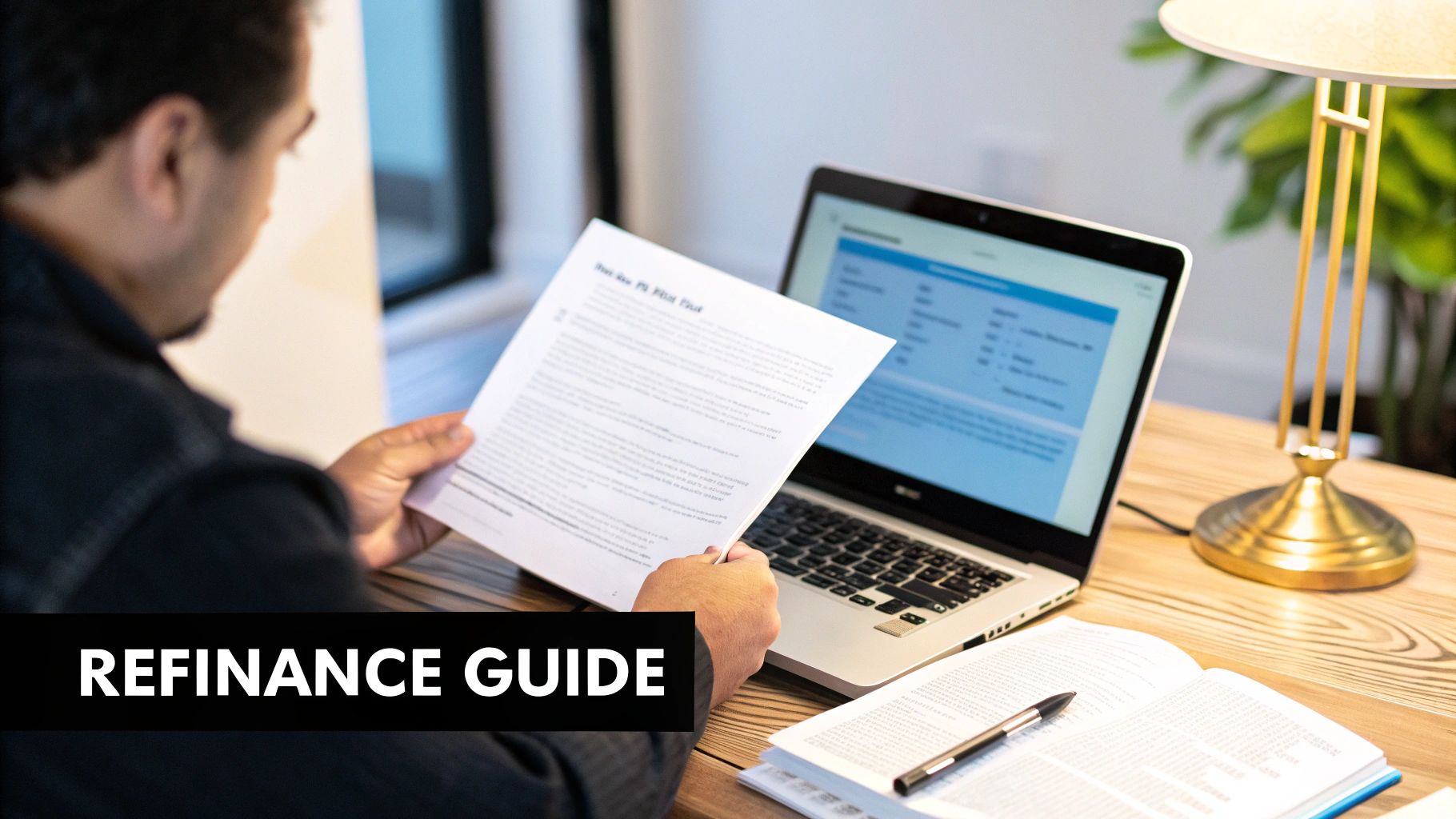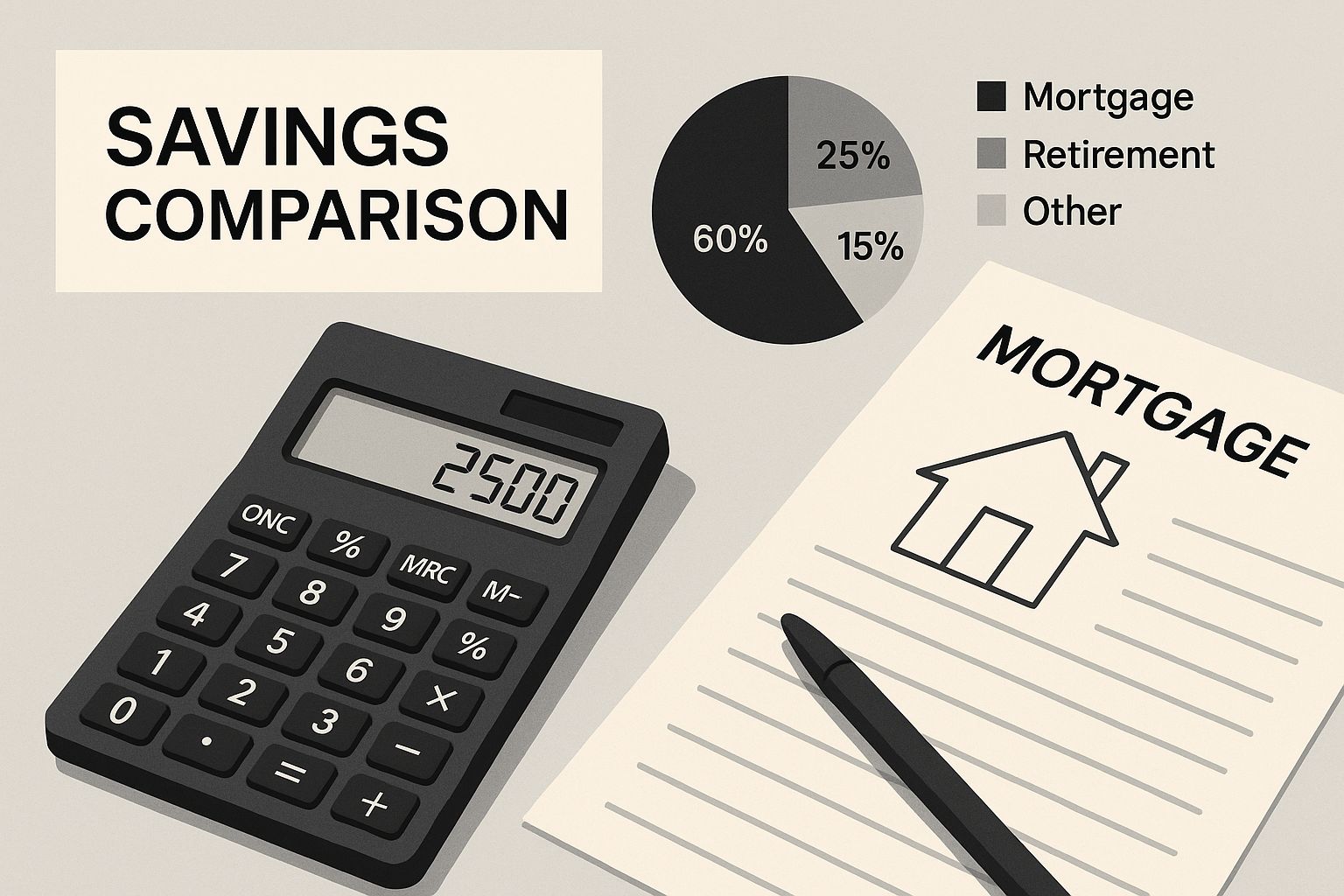Jumbo Loan Refinance Your Guide to Better Rates
November 19, 2025
Unlock lower rates and better terms with our expert jumbo loan refinance guide. Learn the strategies to save money on your high-value home mortgage today.

Refinancing a jumbo loan isn't just about snagging a lower interest rate; it's a strategic financial maneuver. Get the timing right, and you could save hundreds of thousands over the life of your loan. But a mistimed refi can actually end up costing you. The secret is knowing how to spot the specific financial triggers that make a jumbo refinance a smart move for your goals.
When to Refinance Your Jumbo Loan for Maximum Gain

In finance, timing is everything—and that's doubly true when you're dealing with a high-value mortgage. A jumbo refinance shouldn't be a knee-jerk reaction to a news headline. Instead, it’s a proactive play to put yourself in a stronger financial position. Usually, the motivation boils down to one of three things: cutting your monthly payment, slashing your total interest paid, or tapping into your home's equity.
Figuring out that perfect moment means getting crystal clear on what you want to achieve and what the market is doing. Let's walk through the most common and compelling reasons that signal it might be time to make a move.
Secure a Better Interest Rate
This is the classic reason to refinance, and for good reason. On a jumbo loan, even a tiny dip in the rate translates into massive savings. Think about it: dropping the rate on a $1.5 million mortgage by just 0.75% can slash your payment by over $700 a month. Over 30 years, that adds up to more than $250,000 in savings.
Here’s a real-world example I see all the time: A client has a $2 million mortgage on a 7/1 adjustable-rate mortgage (ARM). As their 7-year fixed period is about to end, they notice that rates for 30-year fixed loans have fallen. By refinancing into a stable, fixed-rate loan, they don't just lock in a lower payment—they completely eliminate the anxiety of future rate hikes. That's powerful financial peace of mind.
Expert Tip: Don't just follow the headlines. A real drop in market rates or a significant jump in your credit score are your true green lights to start exploring a jumbo refi.
Shorten Your Loan Term
Here’s a power move for the financially savvy: refinancing from a 30-year term to a 15-year one. Yes, your monthly payment will go up, but the interest you save over the long haul is often staggering. You build equity at lightning speed and own your home free and clear years ahead of schedule.
This strategy is a perfect fit for high-earners who've had a recent income bump and can easily absorb the higher payment. They're essentially trading a bit of monthly cash flow for tens, or even hundreds, of thousands in interest savings. It's a trade-off that pays huge dividends.
Tap Into Your Home Equity
With property values skyrocketing, many homeowners are sitting on a mountain of equity. A cash-out jumbo refinance lets you turn that on-paper wealth into actual cash you can use. You simply borrow more than you currently owe on your mortgage and get the difference as a lump sum.
People pull cash out for all sorts of smart reasons:
- Major Home Renovations: Funding a dream kitchen or an addition that boosts your property's value even more.
- Investment Opportunities: Pouncing on a timely business venture or buying an investment property.
- Debt Consolidation: Wiping out high-interest credit card debt by rolling it into your low-rate mortgage.
- Education Funding: Paying for college tuition without taking out separate, high-interest student loans.
Before you jump in, it's critical to run the numbers on your break-even point—the moment when the savings from your new loan officially outweigh the closing costs. You can use this handy refinance breakeven calculator to see exactly when your refinance starts paying you back. Getting this right ensures your refi is a clear financial win.
Meeting the Tough Standards for a Jumbo Refinance

Let’s be clear: getting a jumbo refinance isn't the same as refinancing a standard home loan. When you borrow above the limits set by Fannie Mae and Freddie Mac, the lender is on the hook for the entire amount. There's no government backing to cushion them.
Because they’re assuming all that risk themselves, lenders put your finances under a microscope. They need to be absolutely certain you are a rock-solid borrower who can handle the debt. This isn't just about qualifying—it's about proving you are an exceptional candidate.
Think of it as the difference between a local community play and a Broadway production. The standards are simply on another level. That's why jumping into this process without preparing your financial profile first is a recipe for disappointment. You need a strategy.
The Credit Score Imperative
With a conventional mortgage, you might squeak by with a credit score in the high 600s. For a jumbo refinance? That’s not going to fly. Lenders are hunting for pristine credit histories that demonstrate years of responsible debt management.
At a bare minimum, most lenders will want to see a 720 FICO score. In reality, the most competitive rates and smoothest approvals go to borrowers with scores of 740 or even 760 and higher. A great score doesn't just get your foot in the door; it directly influences your interest rate, which can save you tens of thousands of dollars over the life of the loan.
Key Takeaway: Your credit report is your financial resume for this application. Lenders will comb through it, looking for any blemishes like late payments or high balances, especially within the last 12 months. A clean report is essential.
Loan-to-Value and Your Skin in the Game
Your Loan-to-Value (LTV) ratio tells the lender one simple thing: how much of your own money is tied up in the property. It’s calculated by dividing your current loan balance by the home’s appraised value. For a jumbo refi, lenders demand to see that you have significant "skin in the game."
Typically, for a rate-and-term refinance, you'll need at least 20% equity, which translates to an 80% LTV. If you’re looking to pull cash out, the bar is even higher. You’ll likely need 25-30% equity, meaning a maximum LTV of 70-75%. This equity acts as the lender’s safety net if you ever default.
Demand for refinancing is climbing, with the refinance share of mortgage applications recently hitting 40.1%. In the jumbo market—loans over $806,500—we've seen some good news. Average interest rates for 80% LTV loans recently dipped from 6.88% to 6.78%. You can explore the full mortgage application survey for more on these trends.
Decoding Your Debt-to-Income Ratio
If there's one number that can make or break your application, it's your Debt-to-Income (DTI) ratio. This metric compares your total monthly debt payments to your gross monthly income, showing a lender how much of your earnings are already spoken for.
Jumbo lenders are incredibly conservative here. While a conventional loan might stretch to a 50% DTI, a jumbo lender will almost always cap it at 43%, and many strongly prefer to see it below 40%.
Let's put this into a real-world context. Say your gross monthly income is $30,000. A 43% DTI means your total monthly debts can't exceed $12,900. This includes everything: your proposed jumbo mortgage payment, property taxes, insurance, car payments, student loans, and credit card minimums. Deciding to buy a new luxury car with a $1,500 monthly payment right before you apply could single-handedly push you over the DTI limit and result in a denial.
The Power of Cash Reserves
Finally, lenders need to see that you have a solid financial cushion. They want proof that if you hit a rough patch—say, a temporary loss of income—you could still comfortably make your mortgage payments. This is where your post-closing cash reserves come in.
These are your liquid assets (think checking, savings, or brokerage accounts) left over after you’ve paid all your closing costs. For a jumbo refinance, it's standard to see a requirement of 6 to 12 months' worth of your new monthly payment (PITI: principal, interest, taxes, and insurance). So, for a new mortgage payment of $10,000, you’d need to show between $60,000 and $120,000 in accessible funds.
Getting Your Jumbo Refinance Application Right the First Time
Let’s be honest: a jumbo refinance application is a beast. Getting it approved quickly isn’t just about filling out forms; it’s about telling a compelling story of your financial stability. A meticulously prepared application is your single biggest advantage. It can mean the difference between a smooth, fast approval and a frustrating ordeal filled with endless requests for "just one more thing."
Think of your application as a presentation to the lender's underwriting team. Your goal is to give them such a clear, organized picture of your finances that they can confidently say "yes" without a second thought. This isn't just about gathering documents; it's about anticipating what they'll look for and having the answers ready. A proactive approach shows you're a serious, reliable borrower—exactly who lenders want for a loan of this size.
Small optimizations at this stage, like finding a slightly better rate or the right loan product, can lead to massive long-term savings. It all starts with putting your best foot forward in the application.

As you can see, the details matter. Optimizing every part of your refinance—from the rate to the term—adds up to significant financial wins over the life of your loan.
Before we dive into the documents, it's helpful to see just how different this process is from a standard mortgage. The stakes are higher, and so are the requirements.
Jumbo vs. Conforming Loan Refinance At a Glance
The table below provides a quick snapshot of the key differences you'll encounter when refinancing a jumbo loan versus a conforming one.
Understanding these distinctions is crucial. A jumbo refinance is a manual, high-touch process where lenders scrutinize every detail because they are taking on more risk.
H3: Building Your Document Arsenal
The sheer amount of paperwork for a jumbo refi can feel daunting, but every document has a purpose: proving your income, assets, and liabilities beyond a shadow of a doubt. Your first big win is getting ahead of this. Don't wait for the lender's checklist to land in your inbox—start assembling your file now.
Here’s what you’ll absolutely need to get started:
- Tax Returns: Your complete federal tax returns for the last two years. That means all schedules, W-2s, and 1099s. No shortcuts.
- Income Verification: Your most recent pay stubs covering a full 30-day period. If you're self-employed, you'll need a year-to-date profit and loss statement and a balance sheet prepared by a professional.
- Asset Statements: The last two months of statements for every single asset account: checking, savings, brokerage funds, 401(k)s, and other retirement accounts. Lenders want every page, even the blank ones with legal jargon.
- Current Mortgage Statement: A copy of the most recent statement for the mortgage you plan to refinance.
My Pro Tip: I always tell my clients to create a secure digital folder on their computer. Scan every document and give it a clear name like "2024 Federal Tax Return - All Pages.pdf". When your lender asks for something through their online portal, you can just drag and drop. It keeps you organized and makes the whole process feel less chaotic.
H3: Get Ahead of Financial "Oddities"
Underwriters are trained detectives. They are paid to spot anything that looks out of place. A large, random cash deposit or a recent income dip will bring your application to a screeching halt while they investigate. You can avoid these delays by explaining things before they ask.
For instance, did your parents gift you $25,000 to pay down some debt before the refi? Don't wait for the underwriter to flag it. Include a signed gift letter from your parents right alongside your bank statements, explaining the source of the funds. Sold a large chunk of stock? Provide the trade confirmations with your brokerage statements.
This proactive approach accomplishes two critical things:
- It saves time. You answer the question before it's even asked, which can save days—or even weeks—of back-and-forth.
- It builds trust. It shows the lender you're transparent and organized, reinforcing that you're a low-risk borrower.
H3: Mastering the Letter of Explanation (LOX)
Sometimes, the documents alone don't tell the whole story. That's where a Letter of Explanation (LOX) comes in. It’s simply a signed letter you write to add context to anything unusual in your financial profile. It’s your opportunity to speak directly to the underwriter.
You might need an LOX for all sorts of things:
- Employment Gaps: Explaining that three-month break between jobs two years ago was for a planned sabbatical.
- Credit Inquiries: Clarifying that the five recent credit pulls were all from shopping for the best mortgage rate in the same week.
- Unusual Deposits: As mentioned above, detailing the source of a large, non-payroll deposit like an inheritance or gift.
Keep your LOX short, sweet, and to the point. State the facts, explain the "why," and confirm it's not an ongoing issue. A clear, concise LOX can turn a potential red flag into a non-issue, keeping your jumbo loan refinance moving swiftly toward the closing table.
Choosing the Right Jumbo Refinance Loan Product
Securing a jumbo loan refinance isn't really the finish line—it's more like the starting block for your next financial chapter. The loan you choose now will shape your monthly payments, interest costs, and overall financial strategy for years. Picking the right one is absolutely critical, because not all jumbo refinance options are designed to do the same job.
The decision is about much more than just grabbing the lowest interest rate you see. It’s about aligning the loan’s structure with your life’s timeline and what you want to achieve financially. What works for a high-earning executive approaching retirement is going to be completely different from what a young entrepreneur who plans to sell their home in five years needs.
Fixed-Rate vs. Adjustable-Rate Mortgages
Your first big fork in the road is deciding between a fixed-rate mortgage and an adjustable-rate mortgage (ARM). A fixed-rate loan is all about predictability. You lock in your rate, and that's that. It’s a fantastic foundation for long-term financial planning.
An ARM, on the other hand, is a strategic trade-off. You get a lower initial rate, but you accept that it will adjust in the future.
The market right now really highlights this difference. As of August 2025, a 30-year fixed-rate jumbo refinance loan is sitting around 6.62% with an APR of 6.66%. These rates are usually a touch higher than what you'd see for a conforming loan—that's the premium lenders charge for taking on the bigger risk. For a closer look at today's numbers, you can review Bankrate's latest data.
Real-World Scenario: Picture a doctor with a young family who needs absolute certainty in her budget for the long haul. She opts for a 30-year fixed-rate jumbo loan. No matter how high market rates climb, her principal and interest payment is set in stone. That's some serious peace of mind.
Now, contrast that with someone who's pretty sure they'll be moving in the next five to seven years. For them, a 7/1 ARM looks much more attractive. This loan gives them a fixed rate for the first seven years—which is often lower than a 30-year fixed—before it starts adjusting annually. The risk of what happens in year eight is irrelevant because they plan to be long gone before that first adjustment ever hits.
Comparing Popular Jumbo Loan Terms
Within both fixed and adjustable-rate categories, you've got choices. Each one brings its own pros and cons to the table.
- 30-Year Fixed-Rate: This is the classic for a reason. It gives you the lowest possible monthly payment, but you'll pay the most in total interest over the life of the loan. It's the go-to if you want to maximize your monthly cash flow.
- 15-Year Fixed-Rate: Think of this as a wealth-building machine. Your monthly payments will be a lot higher, but the interest savings are massive, and you build equity incredibly fast. It’s perfect for homeowners with high, stable incomes who are focused on becoming debt-free sooner.
- 10/1 ARM or 7/1 ARM: These are what I call strategic tools. They give you a decade or seven years of a low, fixed introductory rate. They’re tailor-made for borrowers who are confident they’ll either sell the house or refinance again before that fixed period is up. To get a better sense of the full spectrum of options out there, it's a good idea to explore available refinancing services from different financial institutions.
Rate-and-Term vs. Cash-Out Refinance
Your final decision comes down to defining your "why." Are you refinancing simply to get a better deal on your mortgage, or do you need to pull some cash out of your home's equity?
A rate-and-term refinance is straightforward. You're just swapping your old mortgage for a new one, ideally with a lower rate or a shorter loan term. The loan amount stays pretty much the same.
A cash-out refinance is a different animal. Here, you're taking out a new, larger mortgage. You use it to pay off your existing loan and then pocket the difference in cash. This can be a smart way to fund major home renovations, consolidate high-interest debt, or make a significant investment. Just know that lenders are typically stricter with cash-out refinances, often requiring you to have more equity and a lower loan-to-value ratio.
Getting these core differences straight is essential. For a deeper dive into available loan types and personalized guidance, check out our guide on Tiger Loans jumbo loan options. The key to unlocking the full potential of your jumbo refinance is matching the right product to your specific situation.
Alright, you’ve done the heavy lifting. You've weighed your options, found a great jumbo loan product, and you're nearing the home stretch. This is where the rubber meets the road—locking in that rate and sailing through the closing process. It's not a time to coast; it’s a moment for precision to make sure you get the deal you worked so hard for.
Locking your rate feels like a bit of a strategic dance, especially when the market is all over the place. A rate lock is simply your lender's promise to hold a specific interest rate for you for a set time, usually 30, 45, or 60 days. It’s your shield against market swings while your loan gets finalized. Jump the gun, and you might kick yourself if rates dip. But hesitate too long, and that fantastic rate could vanish.
The Art of the Rate Lock
Knowing when to pull the trigger on your rate lock is one of the most crucial calls you'll make. Nobody has a crystal ball, but you can make a smart, informed decision that could save you a serious amount of money over the life of your loan.
Let's look at the real-world numbers. As of late July 2025, the average jumbo mortgage rate was hovering around 6.85%. While that was a slight dip from the week before, it was still up from the previous month. Even tiny movements add up. At that rate, your monthly payment is roughly $655.26 for every $100,000 you borrow. That paints a picture of a stable but still pricey refinance market. You can always get a closer look at these mortgage rate trends on Bankrate.com.
Choosing your lock period comes down to being honest about your timeline.
- 30-Day Lock: This is your cheapest, fastest option. It's perfect if your financial picture is straightforward and all your paperwork is already in. Think of it as a sprint to the finish line.
- 45-Day Lock: This is the sweet spot for most people. It gives you a comfortable cushion for the appraisal and underwriting to happen without costing much more.
- 60-Day Lock: A longer lock comes with a higher price tag, but it's a smart move if your situation is more complex—say, you're self-employed or you're juggling multiple properties. Paying a little extra for peace of mind is much better than losing a great rate because of an unexpected delay.
My Personal Advice: Don't get greedy. If you've found a rate that hits your financial targets and fits comfortably in your budget, lock it. Trying to perfectly time the absolute bottom of the market is a high-stress gamble that almost never pays off.
Navigating the Closing Table
Once your loan gets the green light and you're "clear to close," you'll get a very important document at least three business days before you sign: the Closing Disclosure (CD). This five-page form lays out the final, exact terms of your loan—your interest rate, monthly payment, and every single closing cost.
Go over your CD like a detective. Compare it, line by line, to the Loan Estimate you got at the beginning. Some third-party fees, like title insurance, can fluctuate a bit, but the big ones, like your lender’s origination fee, absolutely should not.
You'll see a few common fees on that CD:
- Origination Fee: This is what the lender charges to put the loan together.
- Appraisal Fee: The cost to have a professional value your high-end property.
- Title Insurance Fees: These policies protect both you and the lender from any old claims on the property's ownership.
- Escrow/Prepaid Items: Your first payments for property taxes and homeowner's insurance, held in a special account.
- Recording Fees: What your local government charges to make your new mortgage official public record.
On closing day, get ready to sign a small mountain of paperwork. You’ll need a valid government-issued photo ID and a cashier's check or wire transfer for your closing costs. The most important thing you can do is ask questions. If a document is confusing or a fee seems off, speak up. A good loan officer or closing agent will be more than happy to explain it. By taking charge of these final steps, you can sign on the dotted line with total confidence, knowing you've just successfully completed your jumbo loan refinance.
Common Questions About Jumbo Loan Refinancing
When you're dealing with a jumbo refinance, you've probably got the main idea down, but it's the little details that can trip you up or, conversely, save you a fortune. Let's walk through the questions I hear most often from homeowners with high-value properties.
These aren't just hypotheticals. These are the real-world, in-the-trenches questions that come up every single day. Getting the answers right from the start is what separates a smooth closing from a stressful one.
How Much Equity Do I Need to Refinance a Jumbo Loan?
This is almost always the first thing people ask, and for good reason. When it comes to jumbo loans, lenders need to see you have significant "skin in the game." As a general rule, you’ll need to hold onto at least 20% equity in your home.
In lender-speak, this means your loan-to-value (LTV) ratio can't top 80%. So, if your home appraises for $2 million, the absolute maximum you could borrow is $1.6 million. If you're looking to pull cash out or if your loan amount is particularly large, don't be surprised if your lender gets even more conservative, requiring 25% or even 30% equity.
Key Insight: This equity buffer is a lender's primary safety net. A lower LTV drastically reduces their risk if a borrower defaults, making it a hard-and-fast rule in the jumbo world.
Can I Do a Cash-Out Jumbo Refinance?
Absolutely. A cash-out jumbo refinance can be an incredibly smart financial move. I’ve seen clients use the funds to kickstart major home renovations, make strategic business investments, or simplify their finances by consolidating other high-interest debt.
Just be ready for a much closer look from the underwriters. Lenders are naturally more cautious with cash-out deals. They'll likely tighten the LTV requirement to 70% or 75% and may even cap the total cash you can pull out. They need to feel confident that the move makes financial sense for you and doesn't overextend your finances.
Knowing what to ask your lender is half the battle. Our guide on the 10 essential questions to ask before refinancing is a great resource to help you prepare for that conversation and make a truly informed decision.
Are Closing Costs Really Higher on a Jumbo Refi?
In a word, yes. The math is simple. While the fee percentages are often the same as a conventional loan, the dollar amounts are substantially higher because the loan principal is so much larger. You should budget for total closing costs to be somewhere in the ballpark of 2% to 5% of your new loan amount.
Here's a quick look at why those costs add up:
- Origination Fees: A standard 1% origination fee on a $400,000 loan is $4,000. That same 1% fee on a $1.5 million jumbo loan? That's $15,000.
- Appraisal Fees: Appraising a unique, multi-million-dollar property requires a specialist and is far more intensive than a standard appraisal. That expertise comes at a higher price.
- Title Insurance: The premium for title insurance is directly calculated based on the loan amount, so it scales up right alongside your jumbo loan.
These costs are a critical piece of the puzzle when you're calculating your break-even point.
How Long Does It Take to Close on a Jumbo Refinance?
Patience is key here. A standard refinance might wrap up in 30 days, but a jumbo refinance is a different animal. You should plan for a timeline of 45 to 60 days from the day you apply to the day you sign the final papers.
Why the extra time? It all comes down to the manual underwriting process. There are no automated systems for these loans. A senior underwriter will personally review every page of your financial history. The appraisal for a high-value home is also more complex and takes longer to schedule, complete, and review. The best thing you can do is be prepared and hyper-responsive, but it's smart to build this longer closing window into your plans from the start.
Ready to explore your options and see how much you could save? The expert team at Tiger Loans Inc is here to guide you through every step of your jumbo loan refinance. Start your journey toward a better mortgage today.

Alex Chen

Alex Chen













Get in touch with a loan officer
Our dedicated loan officers are here to guide you through every step of the home buying process, ensuring you find the perfect mortgage solution tailored to your needs.
Options
Exercising Options
Selling
Quarterly estimates
Loans
New home

Stay always updated on insightful articles and guides.
Every Monday, you'll get an article or a guide that will help you be more present, focused and productive in your work and personal life.









.png)
.png)
.png)
.avif)
.avif)
.avif)
.png)
.png)
.png)
.avif)
.png)
.png)
.avif)
.png)
.avif)
.png)
.avif)
.avif)